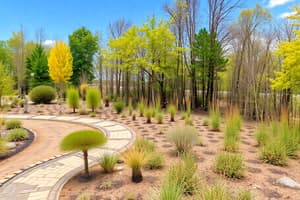Podcast
Questions and Answers
How do development controls relate to the 'Use Zone' of a property?
How do development controls relate to the 'Use Zone' of a property?
- They determine the permitted land uses, such as residential or industrial.
- They dictate the physical and functional nature of the development, complementing the permitted land uses. (correct)
- They establish the market value of the land based on its potential uses.
- They override the Use Zone to allow for flexible development options.
Which of the following best exemplifies a 'specific condition' in development controls?
Which of the following best exemplifies a 'specific condition' in development controls?
- Adherence to standard building codes outlined in the Land Use Scheme.
- Compliance with general environmental regulations for all construction activities.
- Obtaining consent from the local municipality for any modifications to the building facade.
- A requirement for a maximum of 72 seats to be provided on an erf for a place of refreshment. (correct)
What is the primary purpose of development controls concerning the character and functionality of an area?
What is the primary purpose of development controls concerning the character and functionality of an area?
- To ensure a development contributes positively to the area’s character and functionality, considering its context. (correct)
- To standardize building designs across all Use Zones for aesthetic consistency.
- To maximize the economic potential of each development site.
- To ensure new development negatively impacts existing developments.
Which aspect is NOT typically assessed when determining development controls for a property?
Which aspect is NOT typically assessed when determining development controls for a property?
What is the significance of understanding building typologies in the context of development controls?
What is the significance of understanding building typologies in the context of development controls?
What is the main factor that would differentiate the development controls applied to a freestanding building versus a perimeter building?
What is the main factor that would differentiate the development controls applied to a freestanding building versus a perimeter building?
When considering quantitative development controls, what does Floor Area Ratio (FAR) primarily regulate?
When considering quantitative development controls, what does Floor Area Ratio (FAR) primarily regulate?
If a property is situated in Height Zone 5 and the local scheme allows a maximum height of 19 meters, but also states that where the height of a building is specified in storeys only, then a Storey shall be equivalent to a maximum Height of 4,5 metres: what is the max height in storeys?
If a property is situated in Height Zone 5 and the local scheme allows a maximum height of 19 meters, but also states that where the height of a building is specified in storeys only, then a Storey shall be equivalent to a maximum Height of 4,5 metres: what is the max height in storeys?
How does the concept of 'enclosure' relate to building height in urban design?
How does the concept of 'enclosure' relate to building height in urban design?
How is the floor area coverage of a building typically expressed?
How is the floor area coverage of a building typically expressed?
If a building has a ground floor area of 600m² and is constructed on an erf of 1500m², what is the floor area coverage?
If a building has a ground floor area of 600m² and is constructed on an erf of 1500m², what is the floor area coverage?
Given a property with a land area of 1000m², what does a Floor Area Ratio (FAR) of 2.0 allow?
Given a property with a land area of 1000m², what does a Floor Area Ratio (FAR) of 2.0 allow?
A 40,000m² property has 17 dwelling units per hectare (10,000m²). Approximately how many dwellings can be built on the property?
A 40,000m² property has 17 dwelling units per hectare (10,000m²). Approximately how many dwellings can be built on the property?
Aside from minimum number of spaces, what other considerations apply to parking development controls?
Aside from minimum number of spaces, what other considerations apply to parking development controls?
If a new development has a retail space of 500m² and an office space of 1000m², and the local regulations require 5 parking spaces per 100m² for retail and 3 per 100m² for offices, how many parking spaces are required in total?
If a new development has a retail space of 500m² and an office space of 1000m², and the local regulations require 5 parking spaces per 100m² for retail and 3 per 100m² for offices, how many parking spaces are required in total?
What does the concept of 'legibility,' as related to Crime Prevention Through Environmental Design (CPTED), primarily aim to achieve?
What does the concept of 'legibility,' as related to Crime Prevention Through Environmental Design (CPTED), primarily aim to achieve?
What is a primary goal of applying Crime Prevention through Environmental Design (CPTED) principles?
What is a primary goal of applying Crime Prevention through Environmental Design (CPTED) principles?
How do 'street facades' contribute to effective urban design, according to the content?
How do 'street facades' contribute to effective urban design, according to the content?
In the context of street interface, what is the characteristic of an ‘active’ public boundary?
In the context of street interface, what is the characteristic of an ‘active’ public boundary?
How can green building design principles affect local climate?
How can green building design principles affect local climate?
What is the key consideration for developments adjacent to natural open spaces?
What is the key consideration for developments adjacent to natural open spaces?
What is the best explanation of a Built-to-Line.
What is the best explanation of a Built-to-Line.
What defines the requirements of Buildings Lines.
What defines the requirements of Buildings Lines.
Which of the following parameters is considered under solar exposure?
Which of the following parameters is considered under solar exposure?
Which parameters contribute to enclosure along streets?
Which parameters contribute to enclosure along streets?
What is Urban Design according to the slide.
What is Urban Design according to the slide.
Which option is an incentive to improve secure and weather proof cycle facilities at all buildings.
Which option is an incentive to improve secure and weather proof cycle facilities at all buildings.
What should landscaping on sites adjacent natural spaces consider?
What should landscaping on sites adjacent natural spaces consider?
What is a water run-off system an example of?
What is a water run-off system an example of?
Why is the protection of natural open spaces important?
Why is the protection of natural open spaces important?
While deciding parking layout, what does '90' represent?
While deciding parking layout, what does '90' represent?
What calculation method is used to determine area per parking space for assignments and exams?
What calculation method is used to determine area per parking space for assignments and exams?
Which has higher cost of construction?
Which has higher cost of construction?
For most situations, parking requirements are based on:
For most situations, parking requirements are based on:
Legibility and accessibility do not contribute to which of the following?
Legibility and accessibility do not contribute to which of the following?
Flashcards
Development Controls
Development Controls
Rules determining the physical and functional nature of a development.
Use Zone
Use Zone
Regulations specifying permitted land uses, e.g., residential, business, industrial, or mixed-use.
Specific Conditions
Specific Conditions
A document with standard conditions in a Land Use Scheme or specific conditions.
Development Control Objectives
Development Control Objectives
Signup and view all the flashcards
Height (Development Control)
Height (Development Control)
Signup and view all the flashcards
Height and Enclosure
Height and Enclosure
Signup and view all the flashcards
Coverage
Coverage
Signup and view all the flashcards
Floor Area Ratio (FAR)
Floor Area Ratio (FAR)
Signup and view all the flashcards
Density
Density
Signup and view all the flashcards
Parking (Development Control)
Parking (Development Control)
Signup and view all the flashcards
LUM and Urban Design
LUM and Urban Design
Signup and view all the flashcards
Building Line
Building Line
Signup and view all the flashcards
Street Interface
Street Interface
Signup and view all the flashcards
Solar Exposure
Solar Exposure
Signup and view all the flashcards
Green Building Design
Green Building Design
Signup and view all the flashcards
CPTED
CPTED
Signup and view all the flashcards
Study Notes
- Development controls are covered in Unit 7
Use Zone vs Development Controls
- Zoning is an overarching category that splits into use zones and development controls.
- The use zone determines what land uses are permitted, such as residential, business, industrial, or mixed-use.
- Development controls dictate the physical and functional nature of development, including size, appearance, and function.
- Development controls are implemented through standard conditions in land use schemes or specific conditions tailored to a Land Use Scheme.
Example of Specific Conditions
- Tshwane Town-Planning Scheme is a scheme property that describes a portion of land in Hartfield
- Under use zone 28 there are specific uses permitted like a place of refreshment, and places of amusement
- Building requirements include submission of Site Development Plan and Landscape Development Plan
Land Use Considerations
- Land use zones determine the permissible land uses for a property
- Density is how many buildings are one property
- It's important to consider a building's relationship to its surroundings, including building size and layout
- Parking requirements and infrastructure availability are key factors in development
- Functional and aesthetic aspects, like landscaping and fencing, are considered in planning
Reasons for Development Controls
- Development controls ensure a development works functionally on its site, considering parking, landscaping, etc.
- Development controls ensure developments align with the general character of the area.
- Development controls prevent negative impacts on surrounding developments.
- Development controls ensure developments positively contribute to the character and functionality of an area, considering the relationship with pedestrians, public spaces and transport.
- Successful cities require development controls beyond just land use.
- Considerations such as sense of place, placemaking, legibility, and environmental quality are elements of successful cities.
Common Development Controls
- Key development controls include height, coverage, and Floor Area Ratio (FAR).
- Controlling density and having set building lines are common
- Parking requirements, site access, and landscaping are also key
- Façade design and boundary treatments are important considerations
- Managing areas between buildings and the street, solar exposure, and buffer zones are important factors
- Noise and health regulations, including the placement of air conditioners and waste disposal, are typically controlled in a development
Understanding Propery
- Essential site details include shape, dimensions, size, and any existing servitudes.
- Access points (roads etc.), adjacent buildings, and traffic patterns should also be determined
- The Site's topography influences design and development
Building Typologies
- Different building typologies necessitate diverse responses in development control measures, with freestanding and perimeter buildings being common
- Various types of residential buildings exist, including detached, semi-detached, group housing, townhouses, walkups, row houses/terrace houses, and flats/apartments
Quantitative Controls: Height
- Height limitations impact urban structure, form, and corridor definition
- Height influences relationships between buildings, including privacy and sunlight
- Minimum and maximum height regulations exist
- Geological conditions affect building height feasibility
- Height is specified in meters or stories
Height and Enclosure
- The degree to which streets are visually defined by buildings helps create a sense of enclosure
- Enclosure along streets relies on street width, building setbacks, and building height and influences the pedestrian experience
Quantitative Controls: Coverage
- Expressed as a percentage of land area, coverage describes how much property buildings cover
- Restricting building coverage ensures space for parking, landscaping, and open areas
- Greater development intensity calls for larger coverage
Quantitative Controls: Floor Area Ratio (FAR)
- Floor Area Ratio manages development bulk and intensity in an area.
- Typically expressed as a decimal number
- FAR calculates building's total floor area in relation to property size
Quantitative Controls: Density
- Density measures dwelling units in an area, influencing population concentration
- It is expressed as the number of dwelling units per hectare
- In multi-story apartment buildings, FAR is favored instead of density
Quantitative Controls: Parking
- The number of parking spaces relative to the floor area dictates parking requirements
- Parking location relative to buildings is an important design consideration
Qualitative Controls
- Qualitative controls focus on aspects like spatial quality and the relationship with urban design
LUM and Urban Design
- LUM (Likeness, Usefulness, and Meaning) in urban design shapes interactions between people, places, and the environment.
- Urban design focuses on public spaces and their usage
- Buildings shape space
- Site layout, building mass, and facade design are essential
- Crime Prevention through Environmental Design is an important consideration
Building Lines
- Building lines include street, side, and rear building lines
- Buildings must be located where a building line is or further
- Built-to-lines dictate the building's exact position
- Considerations for building lines include street alignment and landscaping
Street Interface
- The street interface is the threshold between public and private areas
- The interface influences the public perception for how someone experiences the street driving, walking or cycling
- Continuity, rhythm, and engagement are key design principles
- Building facades, enclosures, boundary walls, and landscaping contribute to this interface
Interface with Adjoining Development
- Distance and height between buildings are necessary
- Mitigation of noise, dust, and smells
- Buffers, solar exposure, visual impact, and privacy are important to interface
Landscaping and Streetscaping
- Functional benefits include noise reduction and shade provision
- Active interfaces connect buildings with roadways
- Areas should be aesthetically connected and used for landscaping
Solar Exposure
- Optimal site layouts should consider solar exposure
- Site layouts should facilitate optimal building orientation for solar access
- Appropriate building setbacks/building lines need consideration
- A shadow study contributes to the site development plan
Green Building Design
- Orienting the building helps to reduce adverse affects of different weather times during the year
- Green roofs promote ecological benefits
- Weather proof cycle storage is needed to lower need for cars
- The use of solar panels can greatly reduce fossil fuel usage
- Centralized collection facilities promote waste management
- Storm water runoff should be reduced by green pavements and utilizing infiltration measures
LUM and CPTED
- Clear street layouts prevent confusion and improve accessibility
- Territorial reinforcement is used to promote public and private safety
- Proper management and care demonstrates that the members of the community care about the public image
- Not constructing dark alleys will lessen chance of danger
- Natural light is a necessity to keep an eye "on the street"
Studying That Suits You
Use AI to generate personalized quizzes and flashcards to suit your learning preferences.




